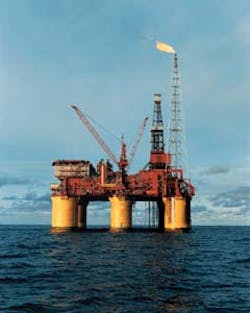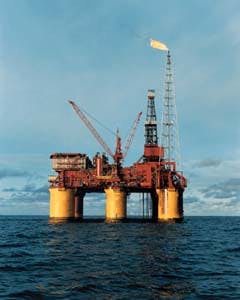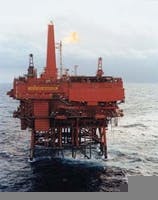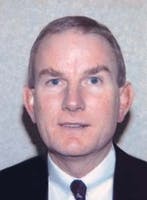Offshore Northern Europe Oryx Squeezes Extra Production From Mature U.K. N. Sea Fields
Martin Cole
Oryx U.K. Energy Co.
Uxbridge, U.K.
Oryx recently spudded a third well in the previously undeveloped Q West area between Hutton and Northwest Hutton fields.
Oryx U.K. Energy Co. was officially appointed as operator of Hutton, Murchison, and Lyell fields in the northern North Sea in January 1995.
This followed a commercial transaction which included the acquisition of interests from Conoco (U.K.) Ltd. and resulted in Oryx being the major equity holder in each of these fields.
What prompted Oryx to increase its stake in these mature areas and to want to take on the responsibilities of operatorship? In a word: opportunity. It was the chance to add value to the fields by extending field lives-by at least 5 years in Hutton and Murchison-and by adopting a new style of working.
Although Oryx had not been an operator in the North Sea since opening shop in the U.K. in 1990 through the $1.1 billion acquisition of a package of BP assets, it had accumulated a significant knowledge base through recruitment of staff from a wide range of operating companies.
Also, the parent, Oryx Energy Co., has a long history of successful operations within the U.S. In this first 5 years in the U.K., Oryx gained a reputation for being a proactive nonoperator with strong views on how things might be improved. The progression to operatorship gave the company a chance to practice what it had been preaching.
Now, after 18 months operating experience, is the management of mature fields bringing the benefits anticipated by Oryx? What has Oryx done that is different? The answers are "yes" and "plenty."
First move
The first, and most important, activity was to assemble the best possible team for the task. Oryx promotes a simple model of three behavioral components-competence, commitment, and collaboration (combining cooperation and communication)-fundamental to effective teamwork.
Oryx contributed only about 10 staff to the new onshore asset team in areas of core competency recognized as safety, subsurface, and commercial management.
Atlantic Power and Gas Ltd. (APG), Aberdeen, was awarded the contract for the provision of field management and support services. The scope of this contract was to supply quality people, facilities, and systems to run all day-to-day operational activities.
The onshore team was further supplemented by some smaller direct contracts with Oryx for specialized activities.
At the transfer of operatorship, all of the Conoco offshore employees were taken on by Oryx, whilst third-party contracts were assigned providing continuity and business as usual offshore during the transition period.
The assembled team for Hutton, Murchison, and Lyell was identified by the acronym LEAP (Life Extension Asset Program). The onshore part of the LEAP team was designed to fit the true asset management philosophy and built up from a zero base through the transition period.
The establishment of an open and trusting relationship between Oryx and APG has been a critical factor.
With the individuals coming from a multitude of backgrounds, some effort was invested in team-building, but self-motivation was a cornerstone of the Oryx and APG recruitment criteria.
The ability to challenge the status quo and make changes to improve organizational effectiveness was unencumbered by a legacy of "corporate baggage."
Team changes
The offshore workforce was inherited as-is and was restructured earlier this year to improve efficiency and to complement the onshore set-up.
New roles were introduced which required a multiskilled workforce and new working practices leading to a 40% reduction in core crew levels. There followed an extensive retraining and competency assessment program to ensure that competency assurance standards were met.
To help facilitate workforce acceptance of this major change, Oryx retained the offshore installations managers (OIMs) on their payroll, and all other offshore staff were given a redundancy package.
A combination of these employees and selected third-party contractors were recruited by APG to fill positions in the new organization.
With the changes that have accompanied the first 18 months of operatorship, the management of people issues has been paramount to Oryx. This requires creating a culture of openness in consultation and seeking consensus that changes must be pursued to improve performance for the benefit of all stakeholders. Furthermore, it requires leadership to promote and maintain this culture.
Since performance is measured by results, it was vital to ensure a common understanding of what results were expected from the integrated LEAP team.
Clearly, at the corporate level the overriding objective is the enhancement of shareholder value, but there was also a perceived need to enhance the asset focus of the LEAP team.
This was achieved by setting clear asset-related targets which are underpinned by incentive programs. Simplistically, performance is measured by results in three areas: safety, production, and operating costs.
A 3D seismic survey recently completed around Murchison field will provide increased definition to the complex southern flank of the field and help identify satellite prospects to be drilled from the platform in 1997.
Safety
The LEAP team was required to submit to the government's Health & Safety Executive (HSE) new safety cases for Hutton, Murchison, and Lyell before the transfer of operatorship.
The compilation of this documentation for a new operator, and most especially the Oryx safety management system (SMS), was a massive undertaking.
The contents and philosophies of the safety cases were a combination of the new LEAP organizational set-up, the corporate policies and safety initiatives of Oryx in the U.S., and the operational procedures of the previous operator. Within a year of this submission and subsequent acceptance by the HSE, the offshore restructuring on Hutton and Murchison necessitated a major redesign of parts of the safety cases for these platforms followed by resubmission and further acceptance.
The establishment of a fully trained emergency response capability is a further example of the unseen (and hopefully unused) competency enhancement in which most of the LEAP team, and some Oryx management personnel, have been extensively involved.
Continuous improvement is the LEAP goal for safety performance. During 1995 this was conventionally measured by the recordable accident frequency rate (RAFR).
However, after this first year of performance tracking the RAFR was at such a low level that its measurement was being affected by rare (and relatively unimportant) events and thus becoming less meaningful as an indicator. The prime measurement of safety performance has now become the high potential incident rate (HPIR).
This change is itself indicative of the LEAP team's goal of continuous improvement. To date, the LEAP safety performance has been outstanding.
Taking on operatorship required enormous management commitment from Oryx. The additional corporate responsibilities associated with the health and safety of the offshore workforce and custodianship of the environment are major components of such commitment.
Production
Oryx has been heavily involved in production, from a subsurface perspective, for many years in the LEAP fields. However, operatorship provides the opportunity to exploit more effectively in-field and satellite opportunities to enhance production.
With an end (albeit extended) to field life in sight, production opportunities must be actively pursued in the near future or they will be forfeited as investment payback diminishes when approaching decommissioning.
In recent months the LEAP team has been running a simultaneous drilling rig program on both the Hutton and Murchison platforms. It is several years since this last occurred.
Even before becoming the operator of the Hutton field, Oryx led the other joint venture partners in support of developing the Q West area between Hutton and Northwest Hutton.
The LEAP team has recently spudded the third well in this previously undeveloped area.
Further investment in Hutton includes a new water-injection pump set and plans for more in-field and Q West wells in 1997.
An aggressive program of workovers is also being maintained in order to optimize injectivity and productivity to improve voidage and balance the water-injection and water-handling capacities.
A 3D seismic survey has just been completed over the Murchison field and surrounding acreage. This was an Oryx initiative which has gained partner support.
New mapping, based on interpretation of this data, will hopefully provide increased definition to the complex southern flank of the field and help delineate satellite potential, which should be drillable from the platform in 1997.
The most recent success with the drill bit on Murchison was from a sidetrack from a shut-in well, redrilled out of a section of collapsed casing. This low-cost sidetrack had initial production of 5,000 b/d of oil.
The approved budget for 1996 also contains a long-reach well in the north of the field, which is planned to be spudded in the third quarter, and process modifications to enhance water-handing capacity.
In addition, the LEAP team is pursuing the possibility of development drilling, processing, and transportation of a satellite to Murchison, which could be on stream early next year. Workover activity and reduction of facilities downtime are also continuing.
Oryx operatorship of Lyell subsea field has not yet yielded significant productivity improvements; however, interpretation of the new 3D seismic is near completion, and many technical studies are under way.
Subsea well intervention has been reasonably successful, despite overheated rig rates. With two new water injectors completed during the first quarter, reservoir pressure is building slowly, and production is expected to increase throughout the year.
Efforts are under way to improve the availability of service from the Ninian Southern platform operated by Chevron U.K. Ltd. There, Oryx also has a major equity position.
Operating costs
The LEAP team has achieved the most tangible results in reducing operating costs, where the benefits of focused asset management are most visible.
Direct operating costs for Hutton and Murchison were reduced by approximately 20% in the first year of operatorship, and a further 10% reduction is predicted by the end of 1996.
From the outset, the LEAP team realized savings in excess of 40% from the previous year in onshore support costs. The major reductions were derived from:
- Relatively small integrated and focused asset team of quality people (about 75) with clarity of purpose.
- Organizational effectiveness, through empowered decision-making and strong emphasis on business planning.
- Few functional support personnel charges.
- Very low-cost, fit-for-purpose information technology and business systems.
- Low-cost office accommodation (in a converted warehouse).
- Outsourcing of noncore work and alignment of key contracts.
- Incentives to control costs and other performance indicators.
This was followed in late 1995 and early 1996 by the offshore restructuring which should reduce offshore manpower-related operating costs by a further 40%. These savings are associated with:
- Core crew, integrated workforce of quality people (about 40 on each platform).
- Organizational enhancements, such as reduced interfaces and strong emphasis on business planning.
- More-effective work practices, including multitasking, campaign maintenance, and continuity of work cycle.
- Innovative well-intervention techniques, incorporating snubbing unit, coiled tubing, and storm chokes.
- Very low-cost, fit-for-purpose information technology and business systems.
- Incentives to control costs and other performance indicators.
- Operational synergies, such as sharing of standby and supply boats and logistics.
The twin-pronged approach to increased reservoir exploitation (and facilities efficiency) and decreased operating costs is crucial in mature fields. Focused effort is needed to maintain this profit margin and defer decommissioning.
Each extra year of Hutton and Murchison production enhances reserves recovery by some 5 million bbl of oil, provides employment and revenues, and creates a further window of opportunity to benefit from other sources. Such benefits might be from oil price, third-party use of infrastructure, improved technology, and lower decommissioning costs. Clearly, success in this quest adds significant value for all stakeholders.
The Author
Martin Cole is manager, development and production, at Oryx U.K. Energy Co. He holds a B.Sc (Eng) in engineering from Kings College, London University, and an MBA from Henley Management College.Prior to joining Oryx in 1990, Cole spent 10 years with Shell U.K. Ltd., and before that worked with Brown & Root Ltd. and various engineering consultancies in the U.K. and abroad.
Copyright 1996 Oil & Gas Journal. All Rights Reserved.



